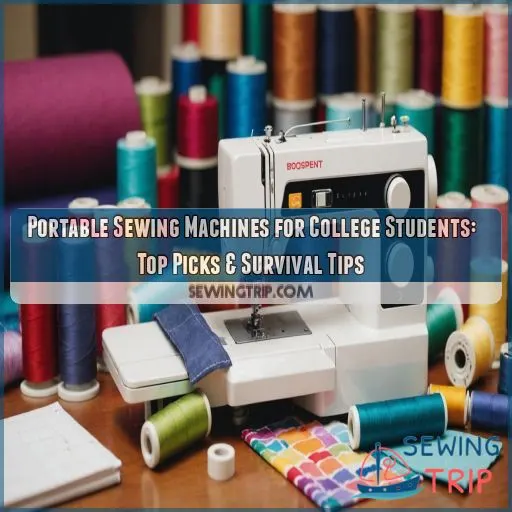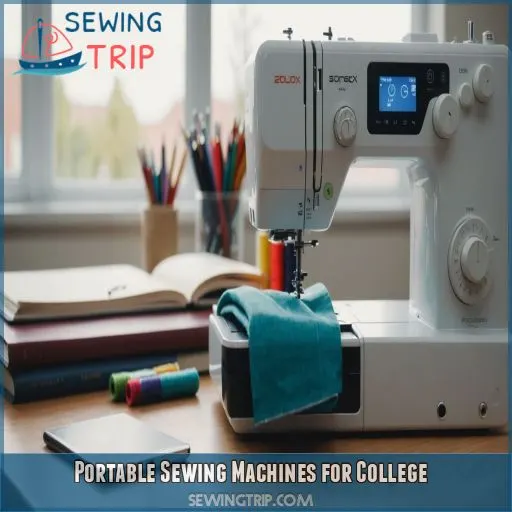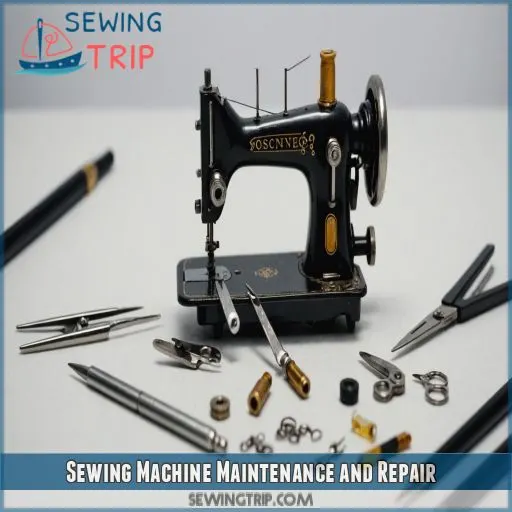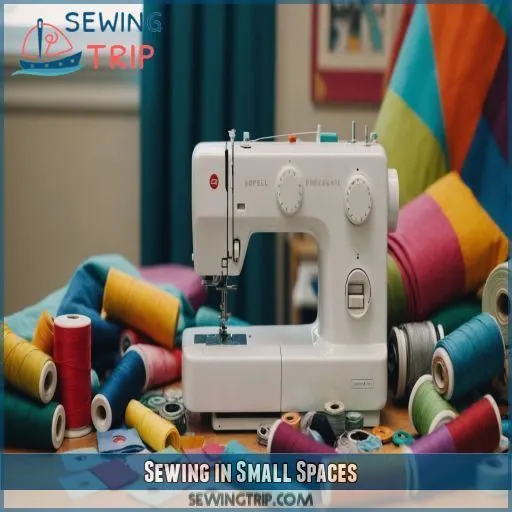This site is supported by our readers. We may earn a commission, at no cost to you, if you purchase through links.

With a portable sewing machine, you’ll be able to express your personal style, whip up last-minute repairs, and even earn some extra cash through custom sewing gigs.
When choosing a machine, prioritize portability – you want something lightweight that won’t hog all your dorm room space.
Look for a compact, beginner-friendly option that can handle various sewing tasks.
Don’t worry, you don’t have to break the bank – there are plenty of affordable options out there.
And, as you’ll soon find out, having a sewing machine in college is a total game-changer!
Table Of Contents
Key Takeaways
- You’re about to unleash your creativity and independence with a portable sewing machine in college – it’s a total game-changer! You’ll be able to express your personal style, whip up last-minute repairs, and even earn some extra cash through custom sewing gigs.
- When choosing a portable sewing machine, prioritize portability – you want something lightweight that won’t hog all your dorm room space. Look for a compact, beginner-friendly option that can handle various sewing tasks, and don’t worry, you don’t have to break the bank – there are plenty of affordable options out there!
- To make the most of your portable sewing machine, establish a regular maintenance routine to keep it running smoothly. Clean out lint and debris after each use, lubricate moving parts, and change your needle every 8-10 hours of sewing – your machine (and your dorm-mates) will thank you!
- With a portable sewing machine, you can turn your tiny dorm room into a cozy sewing nook. Invest in space-saving accessories like a foldable sewing table or a compact storage case, and choose fabrics that are easy to work with and won’t break the bank – happy sewing!
Portable Sewing Machines for College
As a college student, you’re probably thinking about what essentials to pack for your dorm room.
A portable sewing machine might not be at the top of your list, but it should be!
Having a sewing machine in college can be a lifesaver for last-minute repairs, DIY projects, and even earning some extra cash by offering sewing services to your classmates.
Benefits of Bringing a Sewing Machine to College
Bringing a sewing machine to college can be a game-changer! In addition to being a creative outlet and stress relief, it also lets you express your fashion sense on a budget. Plus, you can earn some extra cash by making custom clothes or alterations for friends. Who knew your sewing machine could be a source of freedom and income?
Space and Storage Considerations
The dorm room dilemma – where to stash your sewing machine? Consider these space-saving tips:
- Invest in a sewing machine case to protect your machine and make it easy to tote.
- Use a desk organizer to keep threads, needles, and other supplies within reach.
- Store fabric in labeled bins to keep your stash tidy.
- Choose multi-purpose tools to minimize clutter.
Choosing the Right Machine for College Life
Your trusty sewing machine – it’s about to become your BFF in college! When choosing the right machine for college life, consider a portable one that won’t hog storage space in your dorm room. Look for a lightweight machine with a budget-friendly price tag, perfect for beginners. A compact size and versatility are must-haves for dorm room sewing.
Tips for Transporting Your Sewing Machine
The big move to college! When transporting your trusty sewing machine, invest in a sturdy sewing machine case or dust cover to protect it from scratches and dust. Pack it snugly with clothes or towels to prevent shifting. Consider shipping it or buying a portable one if you’re flying. Your machine (and your dorm-mates) will thank you!
Sewing Machine Maintenance and Repair
As a college student with a portable sewing machine, you’ll want to keep it running smoothly to avoid any last-minute project meltdowns. By learning some simple maintenance and repair tricks, you’ll be able to troubleshoot common issues, find help when you need it, and keep your machine purring like a contented kitten.
Regular Maintenance for Optimal Performance
To keep your portable sewing machine humming, establish a regular maintenance routine. Clean out lint and debris after each use, lubricate moving parts, and change your needle every 8-10 hours of sewing. Don’t forget to wind your bobbins correctly and adjust thread tension as needed. By doing so, you’ll make sure your machine runs smoothly and efficiently.
Troubleshooting Common Issues
The inevitable sewing machine showdown! You’re zipping along, creating a masterpiece, when suddenly, your trusty sidekick jams. Don’t panic! Needle jams, thread tangles, and bobbin problems are common culprits. Check your thread tension, make sure you have the right foot pressure, and adjust your stitch length. For skipped stitches, try rethreading or replacing your needle. Happy troubleshooting!
Finding a Repair Shop Near Campus
Where can I find a sewing machine repair shop near me?" you ask? Well, my friend, you’re in luck! There are several ways to locate trusted technicians for sewing machine repair. First, the good old Yellow Pages can be your best friend. You can also try Google, local classifieds, or online sewing forums.
If you bought your machine from a dealership, contact them first, as new machines often come with a special warranty for free or low-cost servicing. Additionally, if you own a Brother or Singer machine, their websites offer searchable browsers to locate authorized dealers and repair centers.
When choosing a repair shop, make sure they’ve certified technicians and can service your particular make and model of the machine. Most basic sewing machine repairs cost around $75-$100, but remember to factor in the cost of any replacement parts.
Now you know where to find those local repair shops, so your portable sewing machine can stay in tip-top shape!
DIY Repair Tips and Tricks
Now that you’ve found a reliable repair shop near campus, it’s time to learn some DIY repair tips and tricks to save you time and money. Think of it as learning basic first aid for your sewing machine!
- Clean your machine regularly to prevent dust and debris buildup
- Master the art of needle threading and bobbin winding to avoid tangles and knots
- Troubleshoot common issues like uneven stitches or thread breakage to get back to sewing ASAP
Sewing in Small Spaces
Sewing in a cramped dorm room? We’ve got you covered with tips for making the most of your space, from choosing the right fabric for small projects to must-have space-saving accessories.
Tips for Sewing in a Dorm Room
Sewing in a dorm room? You’re not crazy! With a few hacks, you can turn your tiny space into a cozy sewing nook. First, invest in a compact sewing machine and a storage bin to keep your supplies organized. Here are some space-saving setup ideas:
| Setup | Pros | Cons |
|---|---|---|
| Desk & Chair | Good lighting, comfortable | Takes up floor space |
| Floor & Storage Bin | Maximizes storage, easy access | May strain back |
| Bed & Lap Tray | Cozy, lap tray holds machine | Limited workspace |
| Closet & Shelf | Tucks away machine, frees floor | Dark, cramped workspace |
Happy sewing!
Choosing the Right Fabric for Small Projects
Now that you’ve mastered sewing in your dorm room, let’s talk fabrics! For small projects, you’ll want to choose fabrics that are easy to work with and won’t break the bank. Here are four things to keep in mind:
- Fabric weight: Lighter fabrics like cotton and voile are perfect for small projects.
- Project size: Choose fabrics that fit your project’s scale.
- Budget considerations: Affordable fabrics like fleece and flannel are great for beginners.
- Fabric texture: Smooth fabrics like satin and silk are easier to sew than thick or fuzzy ones.
Space-Saving Sewing Accessories
Sewing in a tiny dorm room? No problem! Invest in space-saving sewing accessories like a foldable sewing table or a compact storage case for your portable tools. A mini sewing machine is a must-have for small projects. Look for portable sewing machines with built-in storage compartments or consider a sewing desk with built-in drawers for your sewing supplies.
Time Management for Sewing in a Busy Schedule
Struggling to find time for sewing? You’re not alone! With a few simple strategies, you can make the most of your busy schedule and still enjoy your favorite hobby. Here are some tips to help you manage your time effectively and efficiently:
- Make your sewing machine visible and accessible:** Keeping your machine in a prominent, easily accessible place will motivate you to sew more often. Don’t hide it away in a closet, as you’re less likely to use it if it’s tucked out of sight.
- Schedule dedicated sewing time:** Plan your sewing sessions in advance and stick to them as much as possible. Look at your weekly calendar and block out time for sewing, whether it’s a few hours on a Saturday or shorter sessions during the week.
- Stay flexible:** While scheduling is important, don’t forget to allow for some flexibility. Life happens, and it’s okay to adjust your sewing time if something unexpected comes up.
- Break down projects into smaller tasks:** Instead of feeling overwhelmed by a large project, break it down into smaller, manageable tasks. That way, you can work on it in shorter bursts of time without feeling pressured to finish everything in one sitting.
- Change your perspective:** Think of yourself as a seamstress or someone who embraces sewing as a part of their lifestyle. This mindset shift can make it easier to prioritize and make time for sewing.
- Choose projects that bring you joy:** Select projects that you truly enjoy and are excited about. This will help you stay motivated and make the most of your sewing time.
- Track your progress:** Document your sewing journey, whether through photos, a journal, or social media. Seeing your progress and accomplishments can be a great motivator to keep going.
- Plan your sewing projects:** Decide what you want to sew, choose a pattern, gather the necessary materials, and create a timeline for completing each step. This will help you stay organized and make the most of your sewing time.
- Group similar tasks together:** Grouping similar tasks, such as cutting fabric for multiple projects or sewing similar seams, can save time and help you work more efficiently.
- Create a project kit:** Gather all the materials needed for a project, including fabric, patterns, and notions, and store them together in a kit. This way, you have everything ready to go when you have time to sew.
Frequently Asked Questions (FAQs)
What is the easiest sewing machine to learn on?
Cut to the chase" with the Janome Arctic Crystal Easy-to-Use Sewing Machine – it’s a breeze to learn on, with 15 essential stitches and a user-friendly interface that’ll have you sewing like a pro in no time!
What kind of sewing machines do schools use?
You’re probably wondering what kind of sewing machines schools use! Typically, schools opt for heavy-duty, computerized machines like the Brother CS7000X or Singer Quantum Stylist 9960, which offer versatility, ease of use, and a wide range of stitches.
Do handheld portable sewing machines work?
For handheld portable sewing machines, you get what you pay for – they’re often a ‘stitch in time’ that can’t handle heavy use, so be prepared for limitations and potential frustration.
Which sewing machine has the least problems?
You’re on the hunt for a hassle-free sewing machine! The Janome HD1000, a mechanical powerhouse with a reputation for reliability and minimal issues, gives you more time to create and less time to troubleshoot!
What are the benefits of portable sewing machines for students?
You’re about to tap into your creativity! With a portable sewing machine, you’ll enjoy the freedom to craft anywhere, anytime. Say goodbye to dorm room boredom and hello to stress-relieving stitches, custom clothes, and a chance to turn your hobby into a side hustle.
How do I choose the right portable sewing machine brand?
When choosing a portable sewing machine brand, consider your needs, skill level, and budget. Look for brands offering durability, versatility, and user-friendly features, such as Brother, Singer, or Janome, which cater to various sewing styles and preferences.
Can I use a portable sewing machine for embroidery work?
You can use a portable sewing machine for embroidery work, but consider one specifically designed for embroidery, like the Brother SE700, which offers more stitch options and advanced features to help you master your craft.
What are the essential features of a portable sewing machine?
You’re shopping for a portable sewing machine! Look for essentials like a sturdy metal frame, multiple stitch options (including straight and zigzag), automatic needle threading, and adjustable tension – your future DIY self will thank you!
Are portable sewing machines suitable for heavy-duty sewing projects?
Don’t expect your portable sewing machine to handle heavy-duty projects like a pro. While they’re perfect for small tasks and quick repairs, they might struggle with thick fabrics or bulky materials, so set realistic expectations.
Conclusion
Who would have thought that a sewing machine could be a college student‘s best friend?
Certainly not your parents when they were lugging around those clunky old machines!
But seriously, having a portable sewing machine in college is a total lifesaver.
With it, you can express yourself, earn some extra cash, and even save money on repairs.









